全文HTML
--> --> -->光互连中光子集成(photonic integrated circuit, PIC)[7,8]技术通过同质或异质集成实现在同一衬底上集成多种不同功能的光电子器件, 从而减少了不必要的封装对准并减少芯片损耗. PIC技术有望成为下一代最具潜力的光互连技术[9-11]. In0.53Ga0.47As PIN光电探测器因为具有良好的载流子传输特性和较宽的吸收谱范围(1.0—1.7 μm), 引起了国内外****的广泛重视. 其可以与InP系材料排列组合, 根据需求改变组分浓度而仍然保持晶格匹配, 使得制备出的光电探测器缺陷更少, 复合速率降低, 从而具有更低的暗电流及工作稳定性. 倏逝波耦合波导型PIN探测器[12-15]解除了量子效率和带宽的相互制约, 并通过集成倏逝波导有效提高了光纤与波导之间的耦合效率[16,17], 增加探测器的响应度[18-20].
本文成功设计并制备出了16个倏逝波耦合型光电探测器(evanescent coupling photodetector, ECPD)阵列, 在–3和0 V时的暗电流分别为215和1.23 pA, 有源区面积仅为5 μm × 20 μm的情况下, 仍有较大的响应度, 即0.5 A/W(无减反膜); –3 V偏压下总带宽超过400 GHz, 可以实现400 G以上的并行通信接收系统.
2.1.3 dB带宽的数值计算
本节着重考虑器件吸收区厚度和有源区面积对器件带宽的影响, 3 dB带宽由渡越时间带宽












图1为数值计算的3 dB带宽随吸收区厚度和台面面积的变化曲线. 在综合考虑响应度的情况下, 只有器件的有源区面积减小, 才能减小器件电容, 达到提高RC时间常数限制带宽目的. 器件的有源区厚度需综合考虑, 一方面有源区厚度的增加能够提高RC时间常数限制带宽, 另一方面减少有源区厚度能够提高渡越时间限制带宽. 由图1可见, 当台面长度20 μm时, 最佳吸收区厚度为460 nm, 渡越时间带宽理论值为64 GHz, 对应的3 dB带宽约45.4 GHz. 因此, 吸收区InGaAs厚度设计为最优值460 nm.
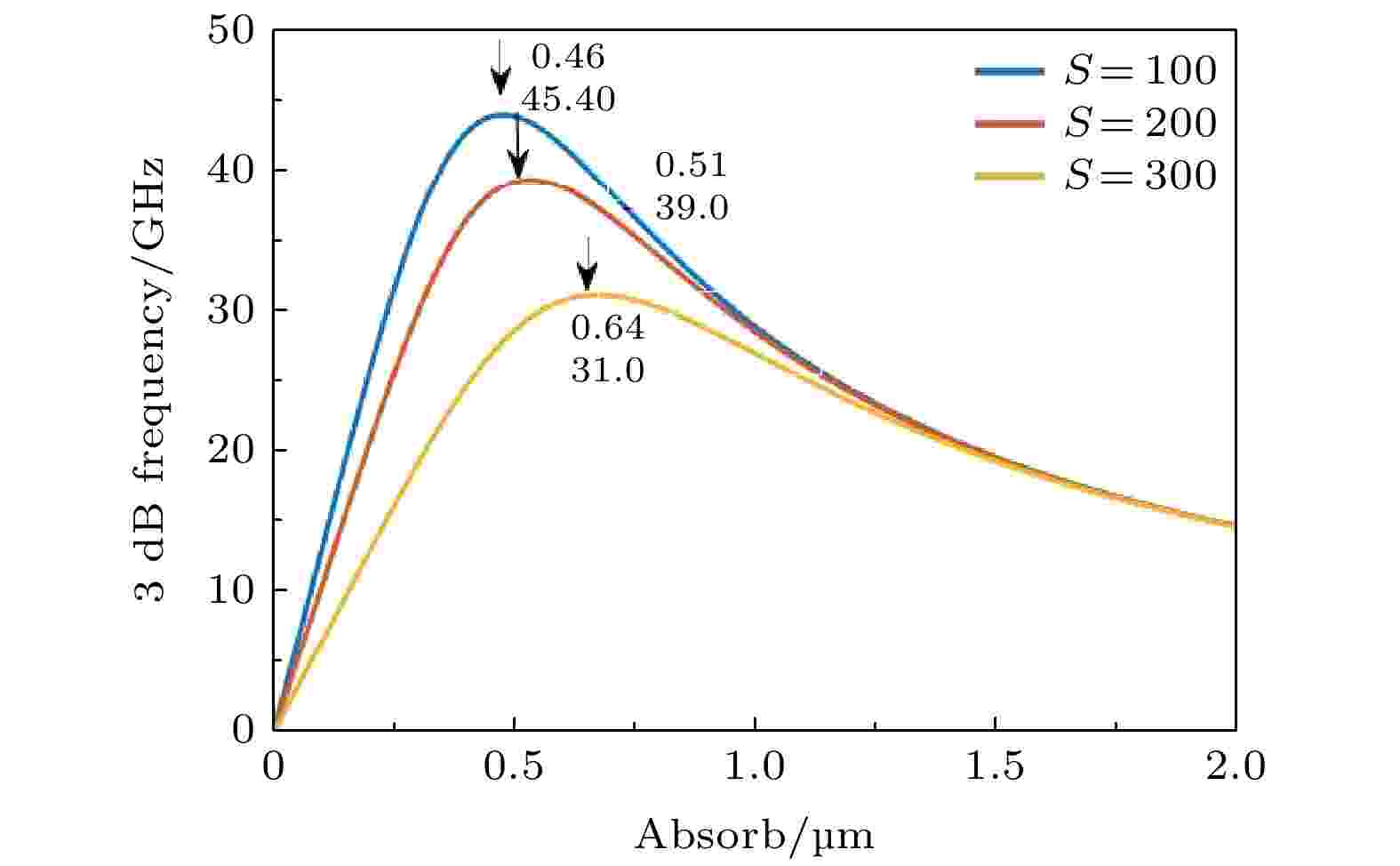 图 1 数值计算的不同吸收区厚度和面积对探测器带宽的影响
图 1 数值计算的不同吸收区厚度和面积对探测器带宽的影响Figure1. Influence of different thickness and area of absorption region on detector bandwidth is obtained by numerical calculation.
2
2.2.倏逝波耦合波导型PIN探测器物理模型构建
倏逝波耦合波导型PIN物理模型以及外延结构见图2和表1. PIN光电探测器位于稀释波导上方, N型重掺杂(Si的掺杂浓度为
 图 2 PIN光电探测器3D结构示意图
图 2 PIN光电探测器3D结构示意图Figure2. 3D structure of PIN photodetector.
| Function | Component | $ {\lambda }_{\mathrm{g}} $ | Doping | Thickness/nm |
| P contact | P-In0.53Ga0.47As | 1.69 | Zn: 1019 | 80 |
| Grading 1 | P-In0.3Ga0.64AsP | 1.32 | Zn: 5×1018 | 5 |
| Cladding | P-In0.18Ga0.39AsP | 1.14 | Zn: 1018 | 410 |
| Spacer | P-In0.18Ga0.39AsP | 1.14 | Zn: 5×1017 | 30 |
| Grading 2 | P-In0.34Ga0.73AsP | 1.396 | Zn: 1017 | 5 |
| Absoption | In0.53Ga0.47As | 1.69 | 460 | |
| Ethc stop 1 | InP | 10 | ||
| n-contact | N-In0.3Ga0.64AsP | 1.32 | Si: 2×1018 | 320 |
| Ethc stop 2 | InP | 10 | ||
| Diluted waveguide | ||||
| Substrate | InP | 500000 | ||
表1倏逝波导耦合PIN探测器外延结构
Table1.Epitaxial structure of evanescent waveguide coupled PIN detector.
探测器吸收区InGa0.53As0.47和宽度设为5 μm, 厚度为460 nm. 吸收波长大于1.69, 使其在很大范围内有较高的光响应度. 在吸收区上方有一层0.41 μm厚的隔离层InGa0.18As0.39P, 用于隔离开P接触层与吸收层, 减少P接触层与金属电极对吸收区光吸收的削弱. 在隔离层两面有约5 nm厚的过渡层, 折射率介于隔离层与吸收层之间, 减少折射率突变带来的回波损耗. 最上方为0.08 μm厚的 In0.53Ga0.47As P接触层, 其掺杂浓度高达1019 cm–3, 便于形成良好的欧姆接触, 减小接触电阻. 通过计算, 确立了探测器吸收区台面面积(5 μm × 20 μm)、吸收区厚度(0.46 μm)及稀释波导结构, 如表1所列. 图2为倏逝波耦合波导型PIN的三维(3D)结构示意图, 可以看到, 入射的高斯光(模斑尺寸为7 μm)首先在稀释波导区发生模式转换耦合, 耦合进去的光逐渐传输到脊波导层中, 然后光沿着脊波导层传输到光学匹配层再慢慢向上耦合进入吸收区被吸收转化为光生电流.
2
2.3.倏逝波耦合光电探测器光场传输模拟
借助光学软件对倏逝波耦合光电探测器进行光场传输的模拟. 图3所示为倏逝波耦合光电探测器光场纵向传输强度分布图, 可以看出, 入射的高斯光首先在稀释波导区发生模式转换耦合, 耦合进去的光逐渐传输到脊波导层中, 然后光沿着脊波导层传输到光学匹配层再慢慢向上耦合进入吸收区被吸收转化为光生电流.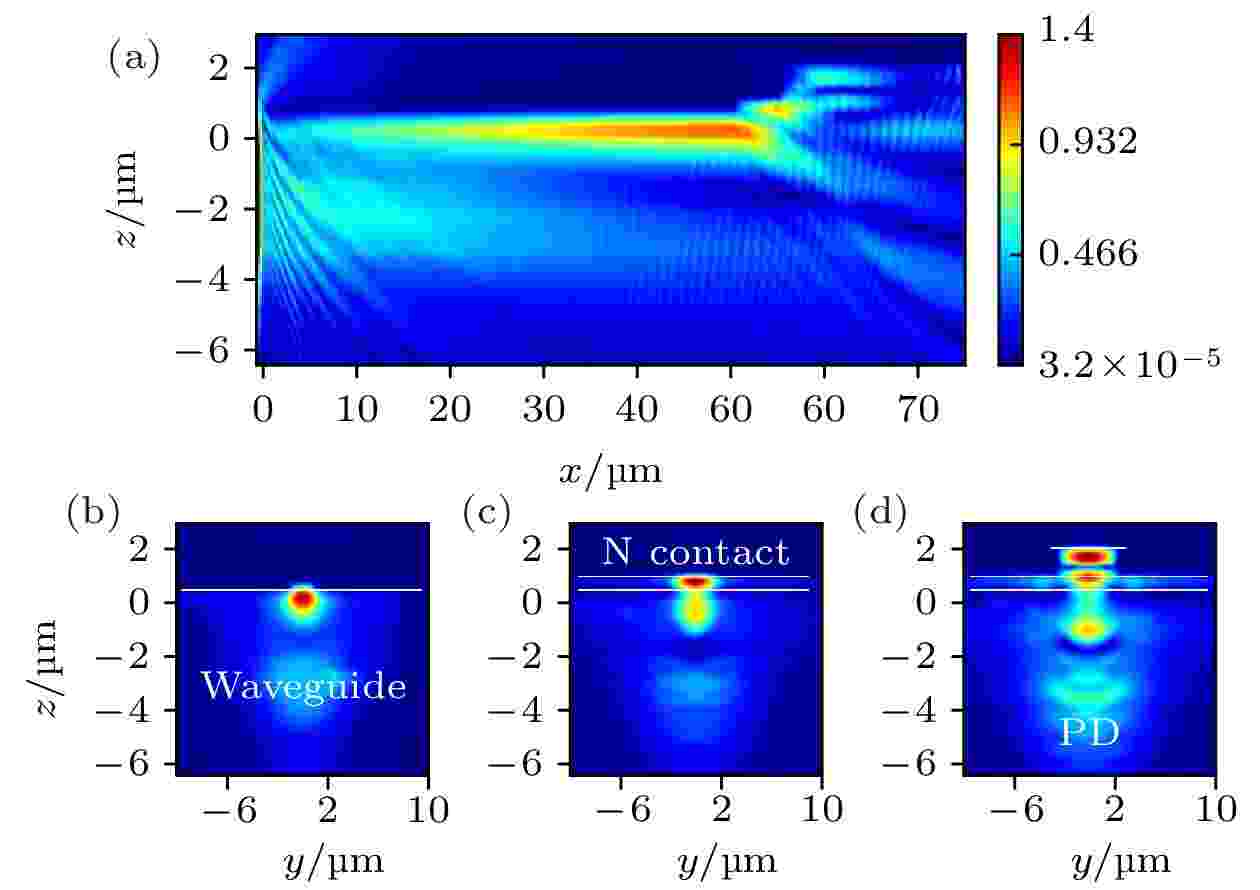 图 3 (a) 倏逝波耦合波导型探测器光场纵向传输强度分布; (b) 光场传输到脊波导时横向电场截面图; (c) 光场传输到光学匹配层时的横向电场截面; (d) 光场被探测器吸收区吸收时的横向电场截面图
图 3 (a) 倏逝波耦合波导型探测器光场纵向传输强度分布; (b) 光场传输到脊波导时横向电场截面图; (c) 光场传输到光学匹配层时的横向电场截面; (d) 光场被探测器吸收区吸收时的横向电场截面图Figure3. (a) Longitudinal propagation intensity distribution of evanescent coupled waveguide detector; (b) cross section of transverse electric field when light field propagates to ridge waveguide; (c) cross section of transverse electric field in optical matching layer; (d) cross section of transverse electric field when light field is absorbed by absorption region of detector.
为了进一步更加直观地说明所设计器件的响应速率, 对器件进行了3 dB带宽的模拟. 在–5 V偏压, 1 mW/cm2小信号下器件在10 MHz—105 GHz的频率范围内的动态响应如图4所示. 从图4可以得到器件的3 dB带宽对应的截止频率为46.8 GHz, 与计算值一致.
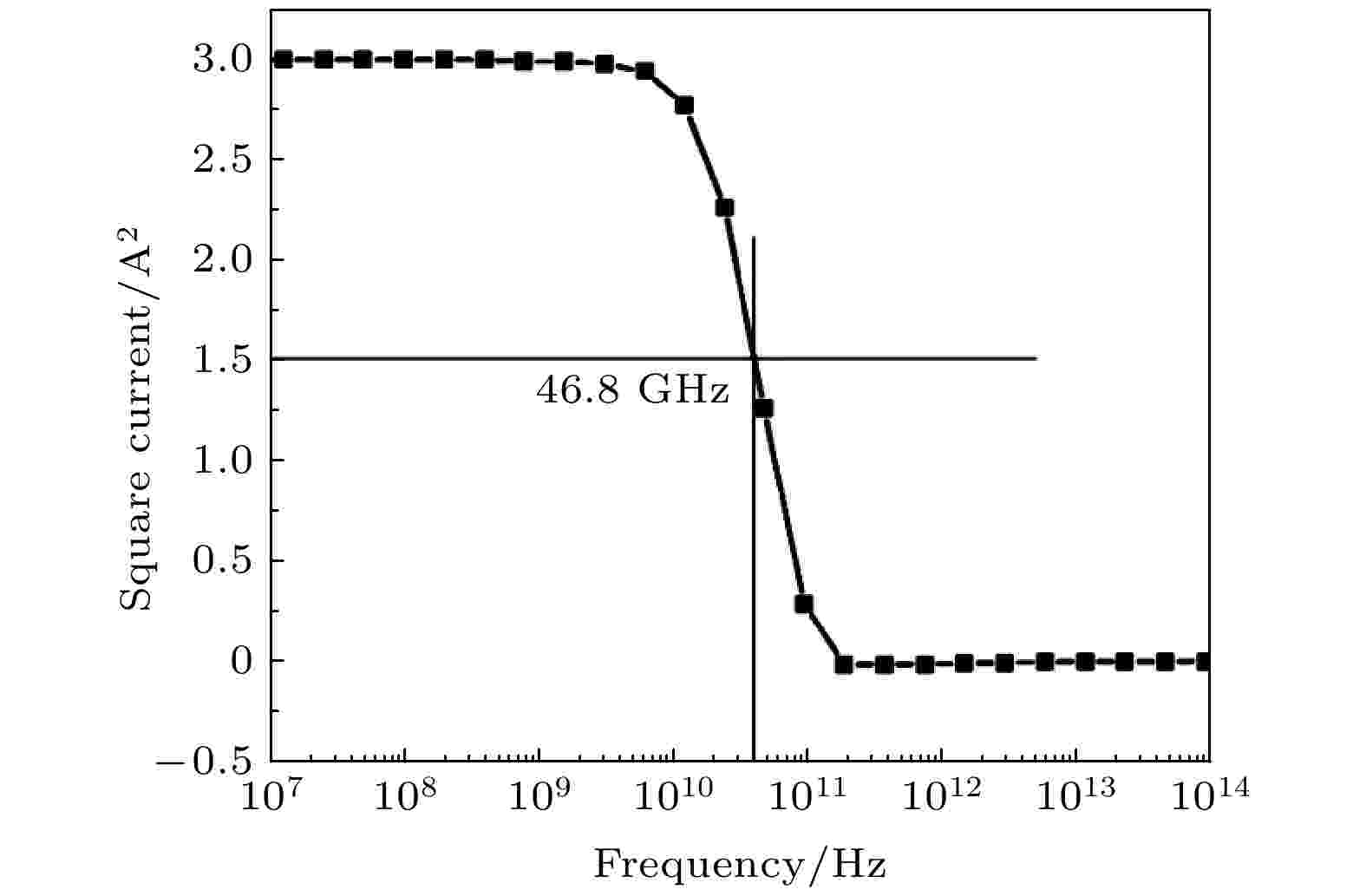 图 4 –5 V偏压, 1 mW/cm2小信号下器件的高频响应
图 4 –5 V偏压, 1 mW/cm2小信号下器件的高频响应Figure4. High frequency response of the device under –5 V bias and 1 mW/cm2 small signal.
 图 5 工艺制备流程图
图 5 工艺制备流程图Figure5. Process preparation flow chart.
对制备的倏逝波耦合型探测器进行暗电流测试, 采用Keithley 4200 SCS半导体参数仪共测试了16个器件. 如图6所示, 器件在–3和0 V时的暗电流分别为215和1.23 pA. 如此小的暗电流表明材料外延缺陷很少, 后期制备工艺对台面表面形貌处理平滑, 制备的器件具有很高的探测灵敏度.
 图 6 器件的暗电流特性
图 6 器件的暗电流特性Figure6. Dark current characteristics of devices.
设定可调谐激光器输出光源波长为1550 nm, 光功率为5 mW, 测试的16个器件有源区尺寸为5 μm × 20 μm, 器件光响应电流如图7所示. 可以看出, 16个器件的光电流最大值可以达到2 mA, 对应的响应度为0.4 A/W; 最小值为1.65 mA, 对应的响应度为0.33 A/W. 解理时波导端面的粗糙度不同以及测试过程中的测量误差都会导致器件最后的响应度差异. 此外, 由于接入波导是拉锥光纤, 自身存在至少1 dB的损耗, 若按照1 dB的损耗计算, 则从拉锥光纤输出的光约为4 mW, 对应的响应度可以达到0.5 A/W.
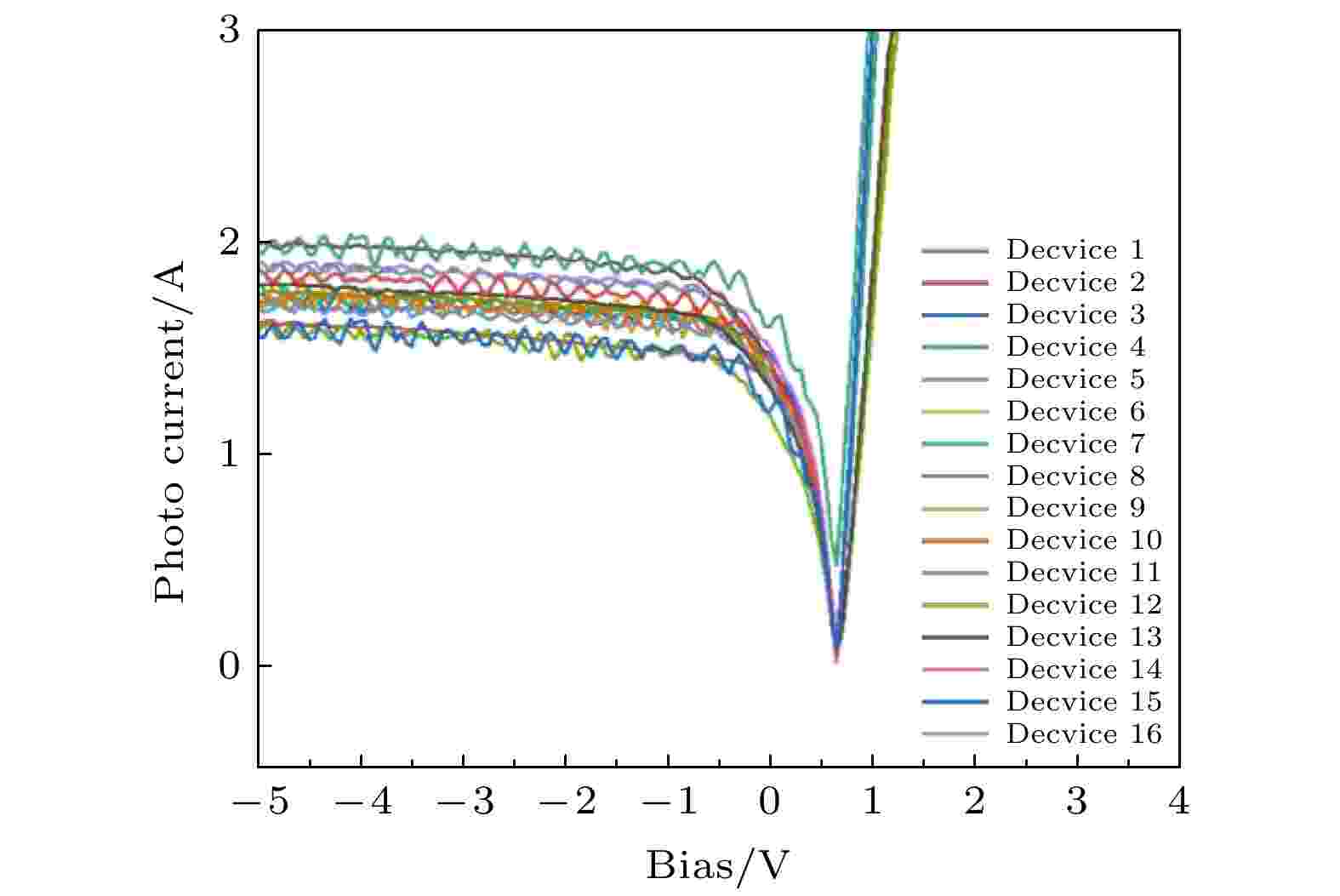 图 7 器件在5 mW功率下的光响应
图 7 器件在5 mW功率下的光响应Figure7. Optical response of the device at 5 mW power.
使用矢量网络分析仪对16个探测器进行器件3 dB带宽的测试. 图8为使用–3 V的偏压对16个器件进行高频响应测试的结果. 可以看到, 每个器件的3 dB带宽均在25 GHz左右, 有的达到28 GHz, 阵列总带宽达到400 GHz以上, 可同时适用于双信道200 Gbit/s的相干接收系统和400 Gbit/s的WDM接收系统. 进一步减小吸收区有效面积和优化合金条件可以进一步提高器件的带宽.
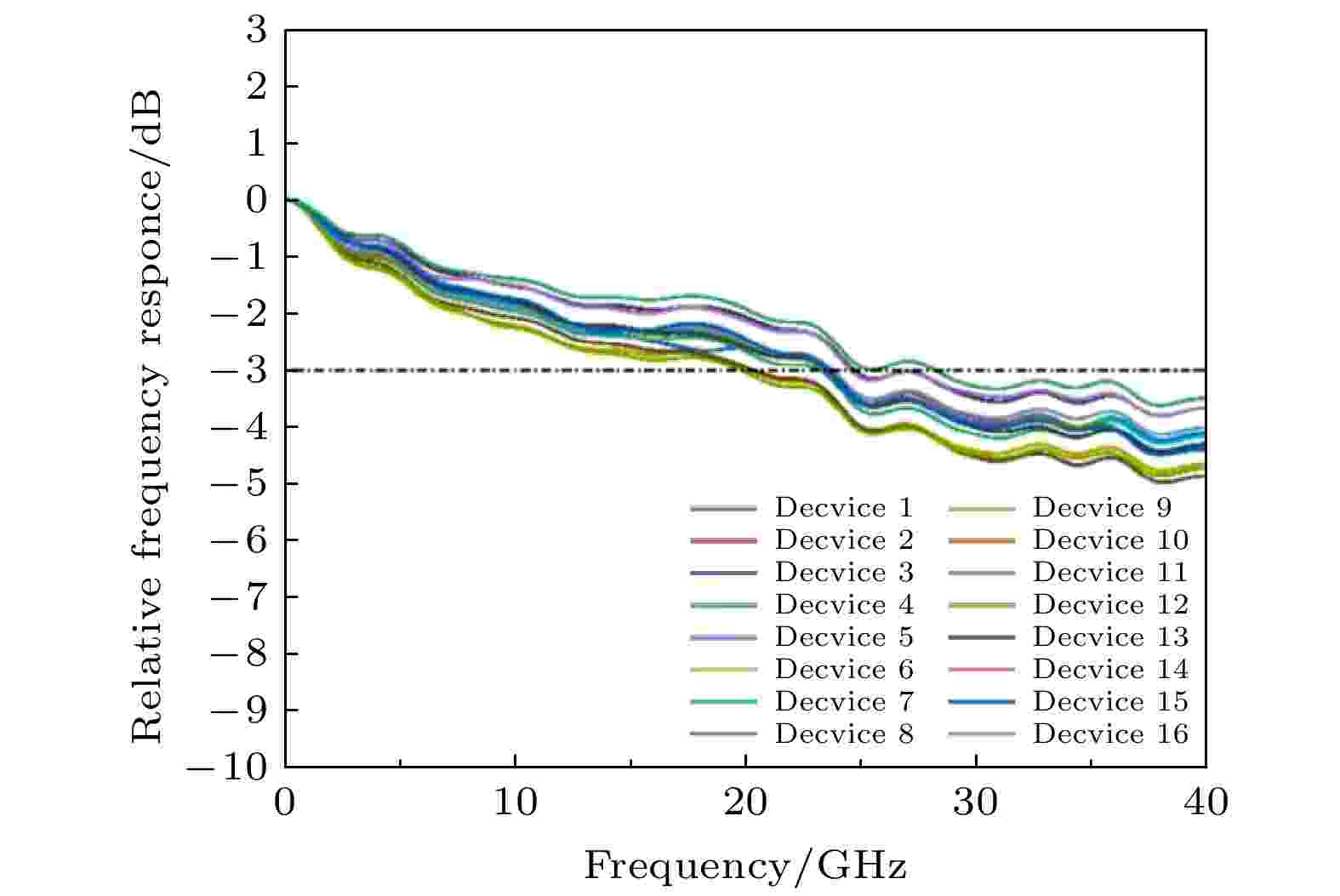 图 8 器件在–3 V偏压下的高频响应
图 8 器件在–3 V偏压下的高频响应Figure8. High frequency response of the device under –3 V bias.
图9为16个器件的3 dB带宽值, 可以看出, 16个器件中带宽最大值为28 GHz, 最小值为22.5 GHz, 最大值与最小值相差仅为5.5 GHz, 表明16个器件具有很好的探测均匀性.
 图 9 16个器件的高频变化
图 9 16个器件的高频变化Figure9. High frequency variation of 16 devices.
